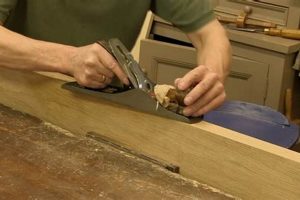
This stationary power tool is primarily used to flatten and straighten the edges and faces of boards. Its function is to create perfectly square edges, which are essential for constructing well-fitted joints... Read more »

This specialized tool is a vital piece of equipment in woodworking, primarily utilized for creating perfectly flat and square edges on boards. It achieves this by passing the workpiece over a rotating... Read more »

A method of joining two pieces of wood, this technique involves creating a projecting element on one piece that fits into a corresponding recess on the other. The projection, acting as a... Read more »

A type of joinery technique used in woodworking, this interlocking method involves cutting a series of complementary, trapezoidal “fingers” into two pieces of wood, which are then glued together to form a... Read more »

An element within the construction where two or more pieces of wood are connected is a crucial aspect of woodworking. These elements, often referenced in resources like the New York Times, directly... Read more »

A finger joint, also known as a comb joint, represents a woodworking technique that joins two pieces of wood together by using a series of interlocking, precisely cut “fingers.” These fingers, resembling... Read more »

The implements employed in creating interlocking connections between pieces of lumber are essential for constructing durable and aesthetically pleasing wooden structures. These implements facilitate the creation of strong bonds via mechanical means,... Read more »

The process addresses the challenge of creating perfectly flat and square edges on lumber. It involves using a specialized machine to remove material from a board’s face or edge, resulting in a... Read more »

A jointer is a woodworking machine designed to produce perfectly flat and square edges on boards. Its primary function is to create a reference surface for subsequent woodworking operations. This is achieved... Read more »

A connection between two or more pieces of wood, achieved through various techniques, forms the backbone of virtually all wooden constructions. These connections range from simple abutments to complex interlocking structures, each... Read more »


